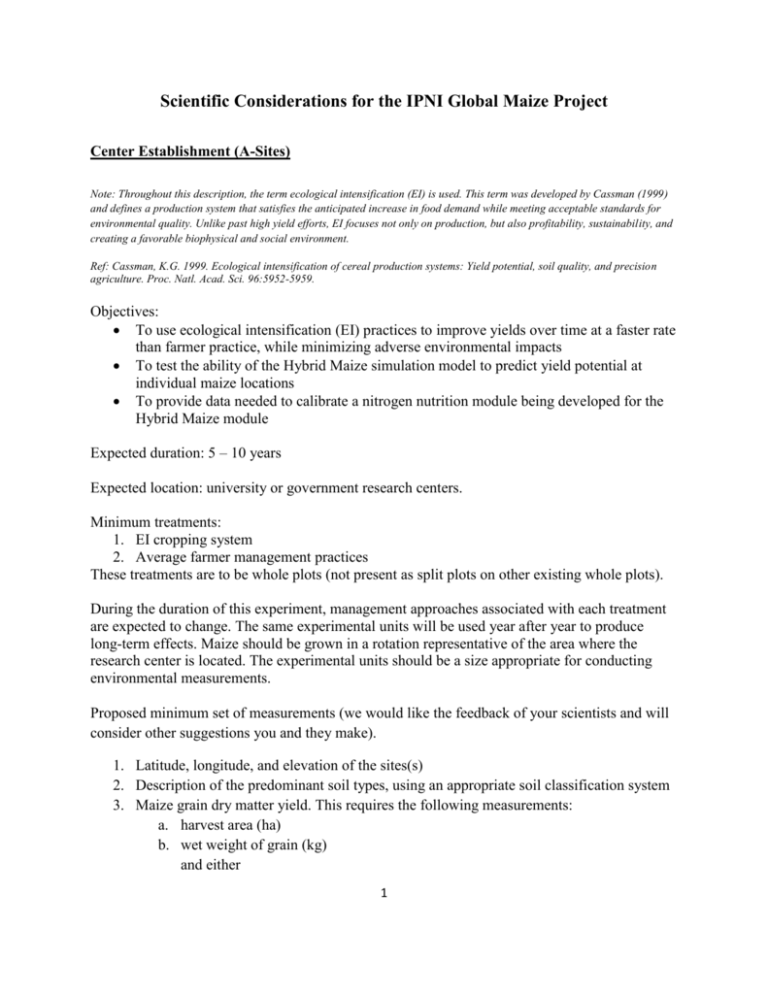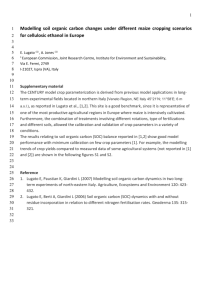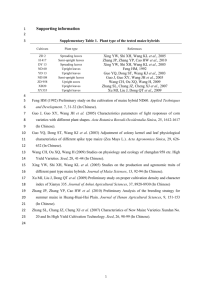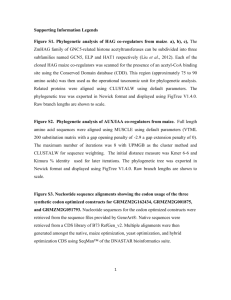Scientific Considerations for the IPNI Global Maize Project
advertisement

Scientific Considerations for the IPNI Global Maize Project Center Establishment (A-Sites) Note: Throughout this description, the term ecological intensification (EI) is used. This term was developed by Cassman (1999) and defines a production system that satisfies the anticipated increase in food demand while meeting acceptable standards for environmental quality. Unlike past high yield efforts, EI focuses not only on production, but also profitability, sustainability, and creating a favorable biophysical and social environment. Ref: Cassman, K.G. 1999. Ecological intensification of cereal production systems: Yield potential, soil quality, and precision agriculture. Proc. Natl. Acad. Sci. 96:5952-5959. Objectives: To use ecological intensification (EI) practices to improve yields over time at a faster rate than farmer practice, while minimizing adverse environmental impacts To test the ability of the Hybrid Maize simulation model to predict yield potential at individual maize locations To provide data needed to calibrate a nitrogen nutrition module being developed for the Hybrid Maize module Expected duration: 5 – 10 years Expected location: university or government research centers. Minimum treatments: 1. EI cropping system 2. Average farmer management practices These treatments are to be whole plots (not present as split plots on other existing whole plots). During the duration of this experiment, management approaches associated with each treatment are expected to change. The same experimental units will be used year after year to produce long-term effects. Maize should be grown in a rotation representative of the area where the research center is located. The experimental units should be a size appropriate for conducting environmental measurements. Proposed minimum set of measurements (we would like the feedback of your scientists and will consider other suggestions you and they make). 1. Latitude, longitude, and elevation of the sites(s) 2. Description of the predominant soil types, using an appropriate soil classification system 3. Maize grain dry matter yield. This requires the following measurements: a. harvest area (ha) b. wet weight of grain (kg) and either 1 c. grain moisture content (%) or d. wet weight of grain sample (g) e. oven dry weight of grain sample (g) 4. Whole plant dry matter accumulation and nutrient (N, P, and K) uptake at physiological maturity. This requires measuring the following: a. dry matter of at least the following plant parts: i. grain ii. cob iii. stover (leaves, stem, husks, tassel) b. nutrient (N, P, K) concentration (% on a dry matter basis) of the following plant parts: i. grain ii. cob iii. stover (leaves, stem, husks, tassel) c. soil organic C (combustion), soil inorganic C, particulate organic matter C, soil bulk density, total N, extractable ammonium-N, extractable nitrate-N, extractable P, extractable K, soil pH (water), electrical conductivity, and particle size distribution on the 3 following depth increments: i. 0-5 cm ii. 5-10 cm iii. 10-20 cm and optionally iv. 20-30 cm v. 30-60 cm vi. 60-100 cm Note: for more information on these tests with references to step-by-step procedures, see pages 29-31 in the file “0802 ARS GRACEnet Follett.pdf” 5. Daily weather data, described in Appendix A. 6. Crop and soil management information, described in Appendix A and B. Data sharing It is our intention for cooperating researchers to share their raw data and associated metadata with IPNI for storage in a data repository for access to all cooperating researchers in the Global Maize project. This sharing can be after an initial period (yet to be determined) that allows researchers to use the data for local purposes first. Please make the co-chairs of the working group know of any issues that arise from this request. Our intention is to consider the individual publication needs of cooperating researchers as well as the need for cross-institutional collaboration that relies on access to more than just local data. 2 Data request An important aspect of this project is the collection of the research and analytical methods used by researchers involved in this project. Please gather from cooperating researchers any procedures and protocols that they use and share them with the co-chairs of the IPNI working group. Yield-Gap-Partitioning Studies (C-Sites). Objective s: to conduct a global, coordinated assessment of the gap between the maize yield obtained by current average farming practices and the yield that can truly be achieved through improved crop nutrition, alone or in concert with other management improvements To test the ability of the Hybrid Maize simulation model to predict yield potential at individual maize locations To provide data needed to calibrate a nitrogen nutrition module being developed for the Hybrid Maize module Expected duration: 1 year Expected location: one at the government or research center where the A-Site exists, and others on farmer fields if possible To attain the objectives, a series of “yield gap partitioning studies” will incorporate some or all of the treatments listed below. Proposed as required: 1. 2. 3. 4. 5. 6. current farmer fertilization practice (FFP) ample NPK (or 3 other nutrients known to be limiting) ample PK (-N) ample NP (-K) ample NK (-P) no NPK (nutrient check) Proposed as optional: 7. FFP + improved crop management practices (ICM), where ICM are improvements in practices other than FFP 8. ICM practices + ample NPK (or other 3 nutrients) Attainable yield is measured in this study by treatment 2 and/or treatment 8 if the latter is implemented. Yield potential is estimated from the Hybrid Maize model, using an appropriate set of local weather data, crop management practices, and soils information. 3 These studies are intended to last one year at a given site (one site-year) and should be located in fields representative of normal crop rotations and management practices used by farmers near the research center (A-site). Proposed minimum set of measurements (we would like the feedback of your scientists and will consider other suggestions you and they make). 1. Latitude, longitude, and elevation of the sites(s) 2. Description of the predominant soil types, using an appropriate soil classification system 3. Maize grain dry matter yield. This requires the following measurements: a. harvest area (ha) b. wet weight of grain (kg) and either c. grain moisture content (%) or d. wet weight of grain sample (g) e. oven dry weight of grain sample (g) 4. Daily weather data, described in Appendix A. 5. Crop and soil management information, described in Appendix A and B. Data request We know that much of these data have probably already been collected in your region. As you meet with scientists, please discuss with them the possibility of them sharing existing data of this sort with the Global Maize project team. We would like to create a central database for storing the raw data from these types of studies so that we can eventually conduct global assessments of yield gaps that exist from lack of proper crop nutrition. 4 Appendix A: Required Data for Running Hybrid Maize, Based upon documentation accompanying the model 5 Description of the Hybrid Maize Simulation Model Hybrid-Maize is a computer program that simulates the growth of a corn crop (Zea mays L.) under nonlimiting or water-limited (rainfed or irrigated) conditions based on daily weather data. Specifically, it allows the user to: Assess the overall site yield potential and its variability based on historical weather data; Evaluate changes in attainable yield using different combinations of planting date, hybrid maturity, and plant density; Explore options for optimal irrigation management; Conduct in-season simulations to evaluate actual growth up to the current date based on realtime weather data, and to forecast final yield scenarios based on historical weather data for the remainder of the growing season. Hybrid-Maize does NOT allow assessment of different options for nutrient management nor does it account for yield losses due to weeds, insects, diseases, lodging, and other stresses. The model is available at: http://www.hybridmaize.unl.edu/ Weather Data Needed by the Hybrid Maize Simulation Model The Hybrid Maize model has two primary simulation modes: 1) long-term (multi-year, with a suggested 10 year minimum period) and 2) single year. In the long term mode, average yield potential is estimated over a number of years while in the single year mode, yield potential for only one year is estimated. An additional option is provided for estimating yield potential either under optimum conditions, where water is not limiting, or under rainfed/irrigated conditions where water is limiting. The minimum set of weather data are different for the optimal or rainfed options, as shown below in Table A-1. Table A-1. Daily weather data required to run the Hybrid-Maize model Data description The following daily weather data must be reported in metric units. These data must cover the entire growing season from either the date of planting or emergence to the date to physiological maturity minimum air temperature (°C) maximum air temperature (°C) total solar radiation (MJ m-2) -can be estimated from minimum and maximum air temperature if solar radiation measurements are not available) precipitation (mm) wind speed (km h-1) relative humidity (%) potential evapotranspiration (mm) – can be estimated from windspeed, relative humidity, min temp., max temp, and solar radiation 6 Water is not yield-limiting Water is yieldlimiting X X X X X X X X X X Obtaining Weather Data for the Hybrid Maize Simulation Model Satellite-derived solar and meteorological data for the entire earth have been put together by the United States National Aeronautics and Space Administration (NASA). The data exist in the Agroclimatology Archive and are available at http://earth-www.larc.nasa.gov/cgibin/cgiwrap/solar/agro.cgi?email=agroclim@larc.nasa.gov. Daily data are available on a 1° latitude by 1° longitude global grid and are listed in Table A-2. To retrieve the data, the user must know the latitude and longitude of the desired location and, optionally, the altitude. If these coordinates are not known, they may be found by using the freely available Google Earth application (http://earth.google.com). The parameters used by Hybrid Maize are in bold font. The labels in the data set differ, depending on whether Option 1 (pre-selected data) or Option 2 (user-selected data) is chosen on the website when retrieving data. Additionally, if altitude is provided as an optional input, maximum, minimum, and average temperatures will be adjusted mathematically for that altitude. Table A-2. Parameters available for download from NASA (bold indicates a parameter that can be used by the Hybrid Maize model). Data set labels for the following data retrieval options Earliest year for Parameter Units Option 1 Option 2 which data exist Year -WEYR YEAR -Day of year -- WEDAY DOY -- Average top-of-atmosphere insolation MJ m-2 d-1 -- toa_dwn 1983 Average solar radiation or average insolation incident on a horizontal surface MJ m-2 d-1 SRAD swv_dwn 1983 Average downward longwave radiative flux MJ m-2 d-1 -- lwv_dwn 1983 Maximum air temperature at 2m above the earth’s surface °C TMAX T2MX 1983 Minimum air temperature at 2m above the earth’s surface °C TMIN T2MN 1983 Precipitation mm RAIN RAIN 1997 Wind speed km h-1 WIND -- missing °C TDEW DF2M 1983 Dew point 7 Average air temperature at 2m above the earth’s surface T2M T2M 1983 Maximum air temperature at 2m, adjusted for the specified altitude -- T2MXC 1983 Minimum air temperature at 2m, adjusted for the specified altitude -- T2MNC 1983 Average air temperature at 2m, adjusted for the specified altitude -- T2MC 1983 RH2M RH2M 1983 Relative humidity °C % Important considerations for preparing weather for the Hybrid Maize simulation model are found in the Hybrid Maize software user’s manual. Management Data Needed by Hybrid Maize Simulation Model The following management data are needed for running the Hybrid Maize model. Requirements differ for optimum and water limited conditions. Table A-3. Site and crop management data required to run the Hybrid-Maize model. Data description Water is not yield-limiting Water is yieldlimiting X or X X or X X X X or X X or X X X Year Date of planting or emergence (one of the following) Date of emergence (month, day) Date of planting (month, day) Seed depth (cm) Maturity (one of the following) Total GDD (10°C basis) Relative maturity and seed brand Planted population Maximum rooting depth (cm) X 8 Topsoil (upper 30cm) characteristics textural class initial moisture status (% field capacity) bulk density (g cm-3) X X X Subsoil characteristics textural class initial moisture status (% field capacity) X X 9 Appendix B: Hybrid Maize N Module Data, from Dan Walters Professor, Soil Science Dept. of Agronomy and Horticulture University of Nebraska 279 Plant Science Hall Lincoln, NE 68583 dwalters1@unl.edu +1 402 472 1506 10 Table B-1. Database Template for Global Maize N Model Development: Required Variables Variables Name Unit Category Description Year Required Year of experiment SiteName Required Name of experiment site or nearest weather station Soil Required Soil series Longitude Required Site longitude Latitude Required Site latitude Texture Required Soil texture class Required* Depth of water table. *Required for the rainfed fields CV_Type Required Cultivar type: open-pollinated or hybrid CV_Name Required Name of the cultivar used General Site Information WTDepth m Management Information PlantingDate dd-mm Required Date of planting MaturityDate dd-mm Required Date of physiological maturity PrevCrop Required Previous crop: ie: maize, soybean, drybean, rice ResidueMgt Required Tillage Required Previous crop residue management: all retained, partially retained, all removed, or burned. Tillage management: ie. conventional, ridge tillage, notill WaterMgt Required Water management: specify whether irrigated or rainfed IrrAmt mm Required* FN kg N ha-1 Required* Total amount of irrigation for the growing season. *Required if irrigated N rate. *Required when including fertilizer N treatments PPD plants ha-1 Required Plant population density Required* NSource Required* Type of N fertilizer. *Required when including fertilizer N treatments Amount of N applied early (ie: fall application in northern hemisphere). *Required if applicable Amount of N applied pre-plant (ie: spring application in northern hemisphere). *Required if applicable Amount of N applied as split application (first split). *Required if applicable Amount of N applied as split application (second split). *Required if applicable Amount of N applied as split application (third plus the rest of the splits). *Required if applicable Amount of manure applied. *Required if applicable ManureType Required* Type of manure applied. *Required if applicable ManureYear Required* Year of manure applied (current, second year since applied, or >= 2 year since applied). *Required if applicable Required Grain yield, 15.5% moisture. The minimum input requirement for a database must include the yield without applied N (Y0). NAmtEarly kg ha-1 Required* NAmtPrePlant kg ha-1 Required* NAmtSplit1 kg ha-1 Required* NAmtSplit2 kg ha-1 Required* NAmtSplit3p kg ha-1 Required* ManureAmt kg ha-1 Plant information Y 12/6/2008 Mg ha-1 11 Table B-2. Database Template for Global Maize N Model Development (Optional Variables) Variables Name Unit Category Description General Site Information Altitude m Optional Site altitude Weather Optional Weather information may be provided (at least containing average daily temperature and rainfall) or simply provide weather data containing temperature and rainfall data during the growing. If available historical weather will also be useful. Management Information CV_Maturity days CV_GDD deg days HarvestDate dd-mm FP kg P ha-1 FK kg K ha-1 Optional Optional Optional Optional Optional Maturity days of the cultivar used GDD (planting to maturity) of the cultivar used Date of harvest P rate (elemental P) K rate (elemental K) Plant information GDM TDM HI UN UP UK Optional Optional Optional Optional Optional Optional Grain dry matter Total above ground dry matter Harvest index Total N uptake Total P uptake Total K uptake Mg ha-1 Mg ha-1 kg ha-1 kg ha-1 kg ha-1 Soil Information Clay % Silt % Sand % SOM % pH Bray_P Olsen_P K_Exc NO3-N mg P kg soil 1 mg P kg soil-1 mg K kg soil-1 mg N kg soil-1 BD g cm-3 12/6/2008 Optional* Clay content, 0-20 cm. *Alternatively provide soil texture classification of the profile Optional* Silt content, 0-20 cm. *Alternatively provide soil texture classification of the profile Optional* Sand content, 0-20 cm. *Alternatively provide soil texture classification of the profile Optional Soil organic matter, 0-8" depth (0-20 cm), or soil organic C, specify the method Optional Soil pH, 0-8" depth (0-20 cm), water-based Optional Bray-1 P, 0-8" depth (0-20 cm) Optional Optional Optional Optional Olsen P, 0-8" depth (0-20 cm) Available K, 0-8" depth (0-20 cm) Residual soil nitrate N before planting, specify sampling depth Soil bulk density, 0-8" (0-20 cm) 12 12/6/2008 13






